SaFEGround – Sustainable, Flexible and Efficient Ground-source energy systems
Research Team:
Imperial College London
David M. G. Taborda (PI), Alex Michaelides, Anastasiya Ostrovnaya, Christos Markides, Matthias Mersch, Niall Mac Dowell, Paul Sapin, Ryan Liu
University of Cambridge
Abir Al-Tabbaa, Benyi Cao, Sripriya Rengaraju
University of Leeds
Leon Black, Kirthika Subramanian Kala
De Montfort University Leicester
Andrew Wright, David Black
Research period: 2021-2024
SaFEGround aims to contribute towards removing current obstacles to the adoption of ground source energy systems as a source of low carbon heating and cooling to residential and commercial buildings. It encompasses a wide range of activities, including:
· material durability for thermo-active foundations (University of Leeds)
· improvement of thermal ground properties (University of Cambridge)
· new design methods for thermo-active foundations (Imperial College London, Civil & Environmental Engineering)
· development of heat pump technology (Imperial College London, Chemical Engineering)
· integrated modelling of building energy management systems (De Montfort University Leicester)
· energy systems modelling at regional and national scale (Imperial College London, Centre for Environmental Policy)
· development of policy and regulatory frameworks (Imperial College London, Business School)
New design methods for thermo-active foundations (David M. G. Taborda, Ryan Liu)
This research included many different aspects of the modelling and design of thermo-active foundations, including the thermal and mechanical effects of introducing local improvements to the thermal properties of surrounding soils (Figure 1), the impact of the number and distribution of pipes within the cross-section of thermo-active piles and group effects (Figure 2). Particular emphasis has been placed on proposing simplified approaches that can be used to estimate the thermal performance of thermo-active piles, both working in isolation and placed in groups.
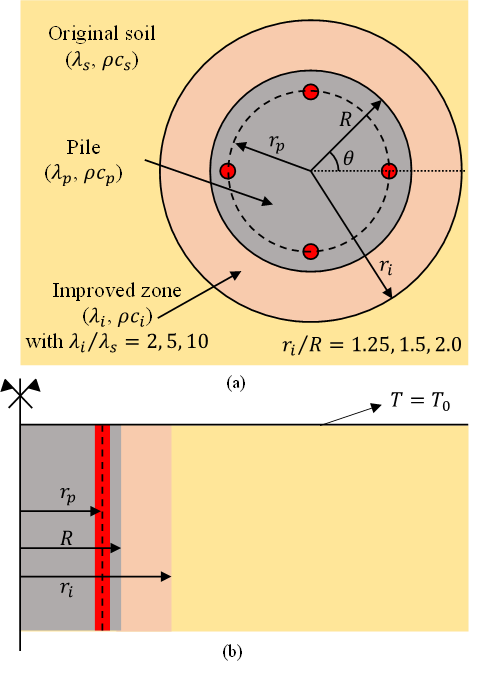
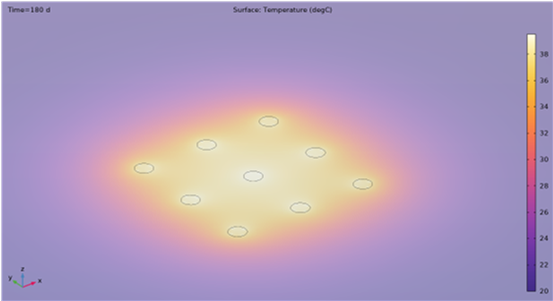
Heat pump technology (Christos Markides, Paul Sapin)
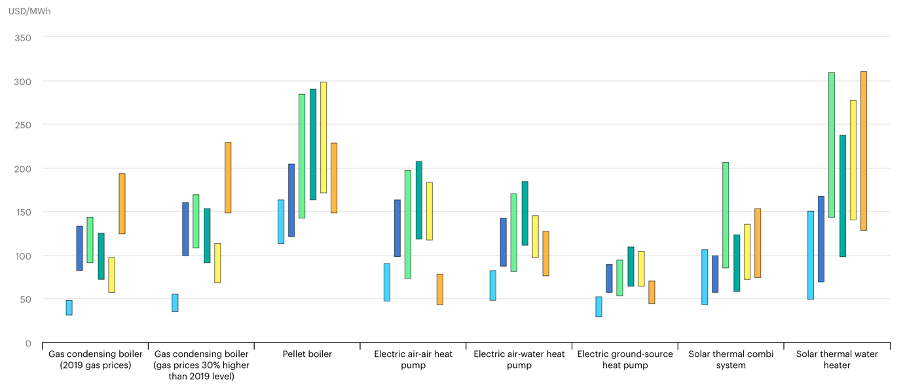
Ground-source heat pumps (GSHPs) appear as the most economically advantageous low-carbon alternative to gas-fired boilers, as illustrated in Figure 3, where levelised costs of heat (LCOH) are reported for various heating technologies for use in different countries. The main reason is that they offer larger COPs than their air-source counterparts (ASHPs), hence lower electricity consumption for similar heating or cooling demands. But despite this higher techno-economic potential, the uptake of GSHPs is nowhere near that of ASHPs.
Aside from the higher upfront costs that can explain the reluctance of end users, the wider adoption of GSHPs is also often hindered by a thorny technical obstacle, or challenge: how to access the ground thermal mass? In particular, how to install GSHPs in the cities? Is it at all feasible? Even for high buildings with high heating/cooling demand and small spatial footprint? And at what cost?
The SaFEGround project aims to provide comprehensive responses to these questions by advancing the design and assessing the techno-economic performance of integrated thermo-active piles (TAPs) ground-source energy systems using reversible water-to-water heat pumps to provide both heating and cooling, as illustrated in Figure 4.
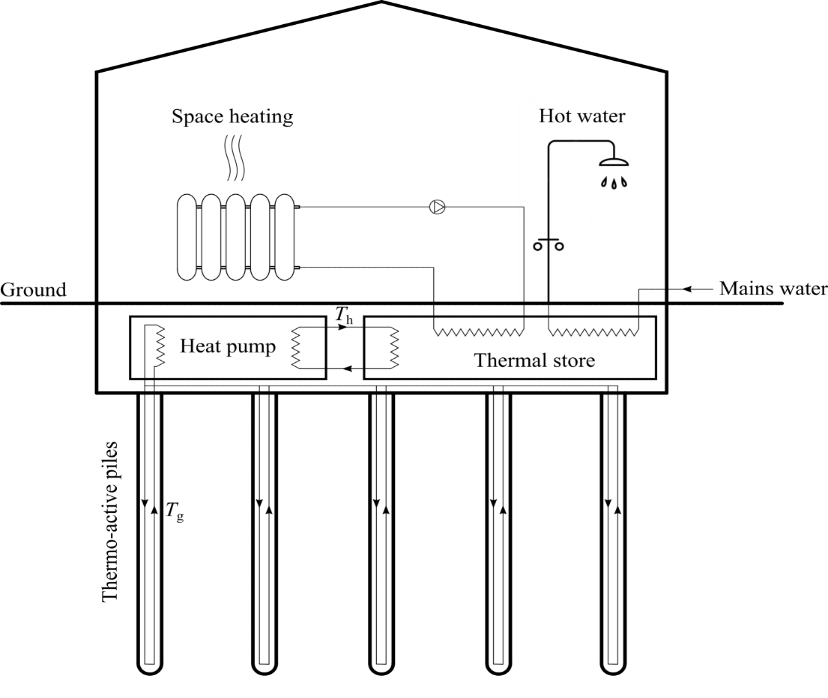
An optimisation framework has been developed based on comprehensive first-law and manufacturer data-driven models to identify optimal design and operational strategies to supply heating and cooling while reducing penalties that heat pump systems pay due to fluctuating (diurnal and inter-seasonal) demand and ground temperatures. Model-predictive control strategies have been developed for optimal day-ahead scheduling of the integrated energy system using fluctuating electricity prices.

The main challenge in optimising the charging schedule of such ground-source energy systems is the high non-linearity that arises from the dependency of the heat pump performance upon the instantaneous ground temperature. In other words, using the heat pump at full capacity at times when the electricity is cheap may not be the optimal strategy as this would lead to significant temperature drops in underground heat exchangers and to the deterioration of the heat pump unit COP, thus incurring larger electricity consumption for a similar heat production. In addition, the temperature at the pile edge must remain above 0 °C to avoid concrete freezing. All these constraints are considered in the in-house developed open-source optimisation framework. An example of an optimal daily operation of a GSES is presented in Figure 5.
Finally, all boils down to one question. With all these constraints imposed on the design and operation of such systems to ensure feasibility, do GSESs based on thermo-active geo-structures remain cheap enough to compete against alternative low-carbon heating/cooling solutions? Preliminary results provide part of the answer. Through design exploration, the techno-economic potential of a TAP‑based ground-source heat pump was optimised and estimated to fall in the range 50-60 £/MWh, which is very promising in view of LCOH estimates provided by the IEA in Figure 3.
National-scale modelling of energy systems (Niall Mac Dowell, Matthias Mersch)
The role and value of ground source heat pumps (GSHPs) in the national energy system transition is assessed using the integrated whole-energy system optimisation model ESO, which has been developed further for this work. ESO is an optimisation model that explicitly considers the electricity, domestic and commercial heating, industrial heating, hydrogen, and carbon removal sectors, as shown in the figure below. The model optimises the evolution of the technology portfolio, starting from the installed capacities today and considering investment and decommissioning decisions until 2050. At the same time, the operation of technologies in different years is optimised with hourly resolution. This allows us to identify optimal whole-energy system transition pathways, to quantify the role and value of technologies throughout the transition, and to assess the impact of different policies or other decisions.
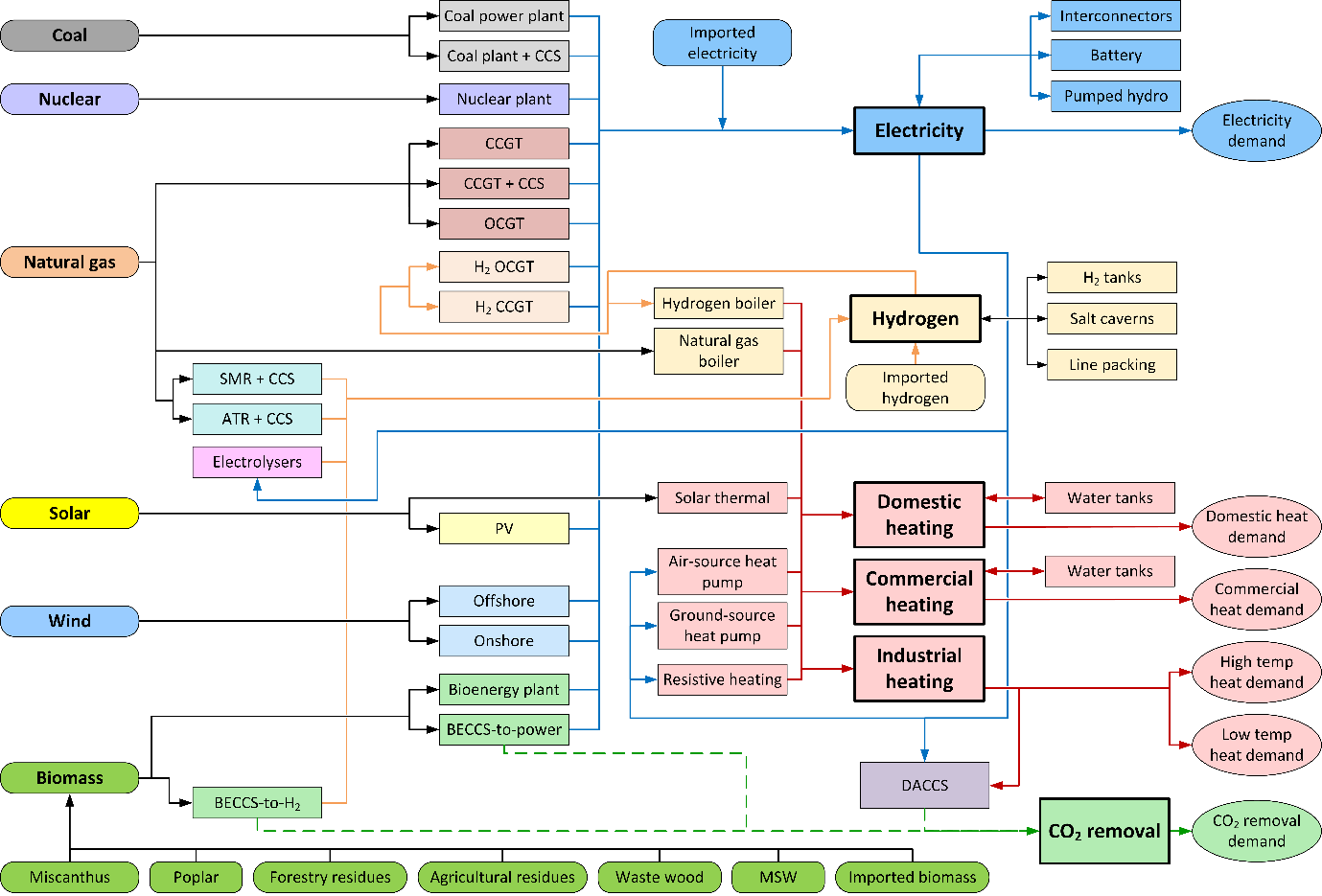
The model has been used for an initial study analysing optimal energy systems transitions under fuel price uncertainties, published in iScience. Further studies specifically looking at GSHPs in the energy system are ongoing. The aims are to evaluate the value of such systems in the decarbonisation of heating, economics of GSHPs and potential subsidies required for large‑scale roll-out, as well as the interaction with the wider energy system, such as the electricity supply.
Key outputs:
· Liu, R. Y. W., Taborda, D. M. G. (2023a) Thermal performance of thermo-active pile groups. 10th European Conference on Numerical Methods in Geotechnical Engineering NUMGE2023, London, UK. doi: 10.53243/NUMGE2023-224
· Liu, R. Y. W., Taborda, D. M. G. (2023b) Effect of pile spacing on the thermal performance of thermo-active pile groups. Symposium on Energy Geotechnics SEG23, Delft, Netherlands.
· Mersch, M., Markides, C. N., Mac Dowell, N. (2023) The impact of the energy crisis on the UK’s net-zero transition. iScience, 26:4, 106491. https://doi.org/10.1016/j.isci.2023.106491
· Sapin, P., Olympios, A.V., Mersch, M., Markides, C.N. (2023) Design and operational optimisation of an integrated thermal energy storage ground-source heat pump with time-varying electricity prices. 14th IEA Heat Pump Conference, Chicago, USA.
· Taborda, D. M. G., Bortolotto, M. S., Liu, R. Y. W. (2023) Influence of pipe arrangement and improved thermal conductivity on the response of thermo-active piles. 10th European Conference on Numerical Methods in Geotechnical Engineering NUMGE2023, London, UK. doi: 10.53243/NUMGE2023-381
· Liu, R. Y. W., Taborda, D. M. G. (2024) A simplified methodology for determining the thermal performance of thermo-active piles,. Environmental Geotechnics. https://doi.org/10.1680/jenge.22.00119
Contact Geotechnics
Geotechnics
Civil and Environmental Engineering
Skempton Building
Imperial College London
South Kensington Campus
London, SW7 2AZ
Telephone:
+44 (0)20 7594 6077
Email: j.otoole@imperial.ac.uk
Alternatively, view our people lists
Follow us on Twitter: @GeotechnicsICL
We are located in the Skempton Building (building number 27 on the South Kensington Campus Map). How to find us
